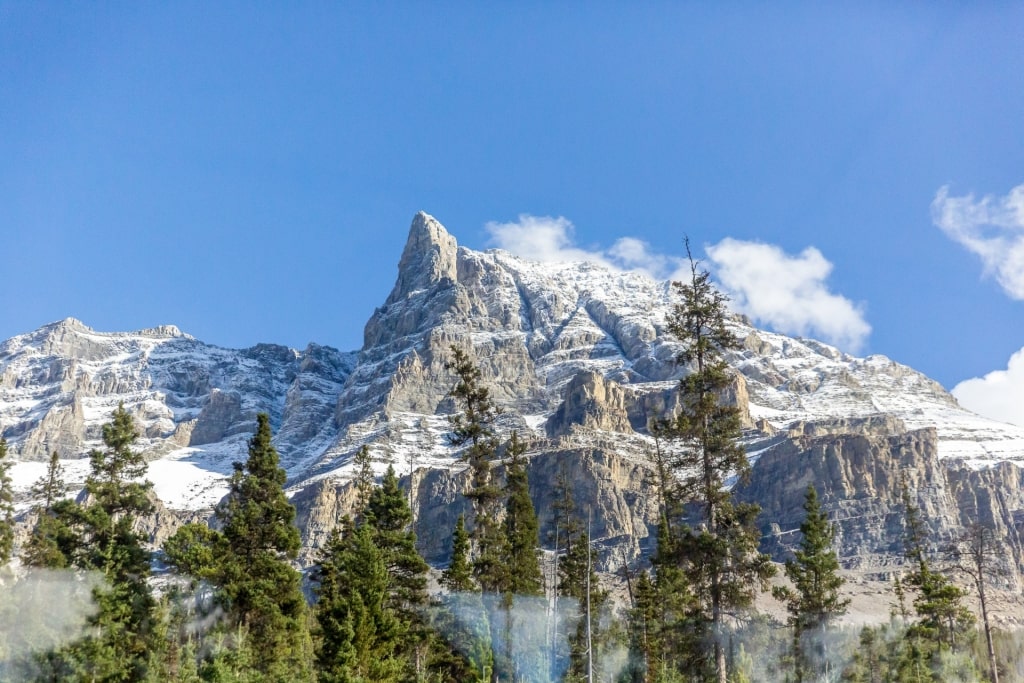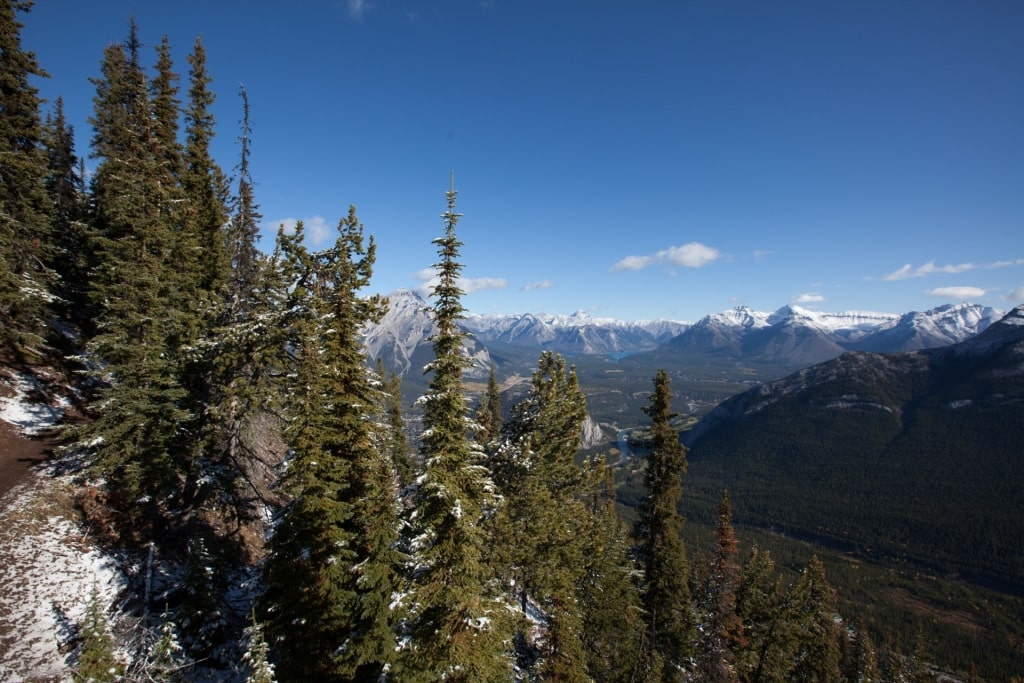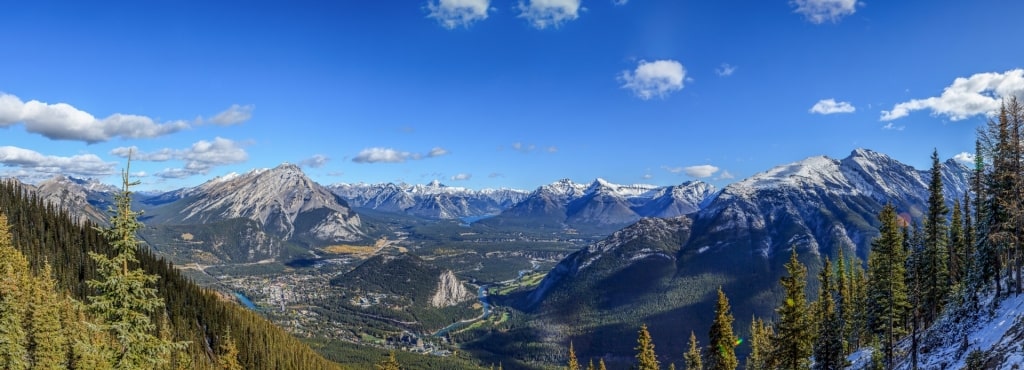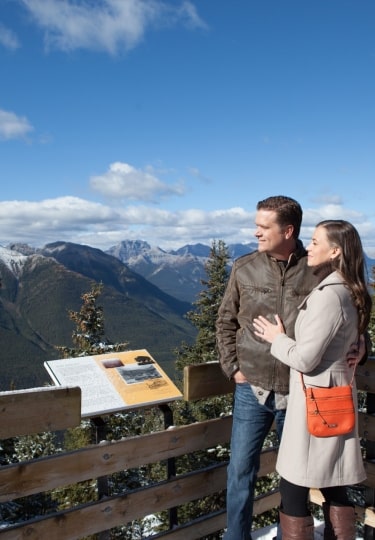The best time to visit Banff is during peak summer season, July and August, with warm, but not sweltering temperatures. It’s perfect for exploring the pristine lakes and wilderness in this part of the Canadian Rockies.
Alberta’s Banff National Park is marked by mountain weather, which can be erratic. Always dress and be prepared for sudden temperature changes.
Visiting Banff By Season

Banff Springs
Summer
Summer is the best time to go to Banff, especially in July and August, to take advantage of long days for embracing the outdoors, relatively snow-free mountain scrambles, and backcountry hiking.
Average highs hover around 72°F (22°C), although lows can dip down to 45°F (7°C); wear layers and bring a protective outer shell with you.
Thanks to around 16 hours of daylight, the lakes are ice-free, and the wildflowers are in bloom. During the summer, you can explore Banff’s lake trails, including Lake Louise; go mountain biking; and scramble up the slopes of Mount Temple and Cascade Mountain for vistas across the Continental Divide. Summer is also peak season, so you won’t be alone here.
Fall
Fall in Banff is when the weather begins to cool off. September and October highs average around 50°F (10°C), but nights can fall to a chilly 30°F (-1°C). The latter part of November, technically still autumn, is when ski season usually opens.
In September and October, there’s still enough daylight (around 13 hours) and warmth for hiking many of the park’s mountain trails—assuming an early October snowstorm hasn’t swept in. Fall is also when Banff’s deciduous golden larches turn orange and gold, putting on a spectacular color show.
Winter
During winter in Banff, you’ll find frozen lakes, ice skating, and powdery snow. December and January’s highs average around 24°F (7°C).
Lows in January (the coldest month) drop down to 5°F (-15°C). Wind chill and temperature falls can make it feel colder still. The shortest day of the year, December 21, clocks in at just under eight hours of daylight.

Banff mountains
Spring
Come spring, the local climate begins to warm, although you’ll still experience plenty of cold, with snow lingering on the mountains. April highs of 36°F (2°C) creep above the freezing mark, with lows around 30°F (-1°C). Springtime weather is variable and can change without warning.
The region’s wildlife, including bears, becomes more noticeable in spring as animals emerge from their winter hibernation.
When is Rainy Season?
Banff’s alpine climate and northern latitude mean weather conditions can vary widely from valley to valley. That being said, summer generally sees the most rain, starting as early as mid-April, and extending into October.
June and July are the rainiest months, with around 16 days of rain each. August and September typically see rain averages drop off, with around 10 rainy days in September. A thermal soak in Banff Upper Hot Springs—one of the best hot springs in the world—is the perfect way to stay toasty outside while enjoying the rain falling upon the forest.

Banff Springs
When is High Season?
Tick July and August off on your calendar as Banff’s high season. Despite occasional rain showers, the weather is sublime, perfect for nature enthusiasts.
Lake ice sheets have melted, and mountain greenery has exploded. Canoeing, fly fishing, hiking, and rafting are just some of the activities you can indulge in come summertime.
When is Shoulder Season?
Fall is Banff’s shoulder season, although May and early June are also considered a lowish season. Snow, rain, sunshine, fluctuating temperatures, and cold nights mean considerably fewer tourists visit during autumn.
In the fall, you can still hike and mountain bike, especially at lower elevations, and take in the golden larch needles, although the glacier lakes will probably still be covered by ice.

Banff Springs
When is Low Season?
Because Banff is a national park brimming with magnificent nature year-round, the area doesn’t really suffer from a prolonged low season. As noted, fall and late spring are considered the shoulder seasons—but you’ll still find plenty to do, assuming you’re prepared to deal with variable weather conditions.
If Banff has piqued your interest, browse our Cruisetours, then book a trip into the Canadian Rockies to experience Banff’s natural splendor for yourself.



